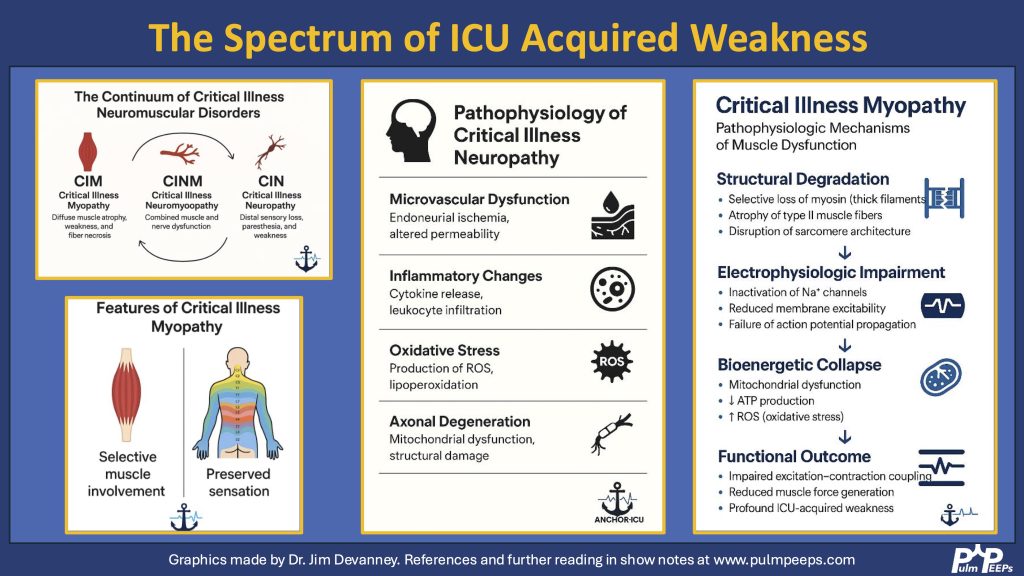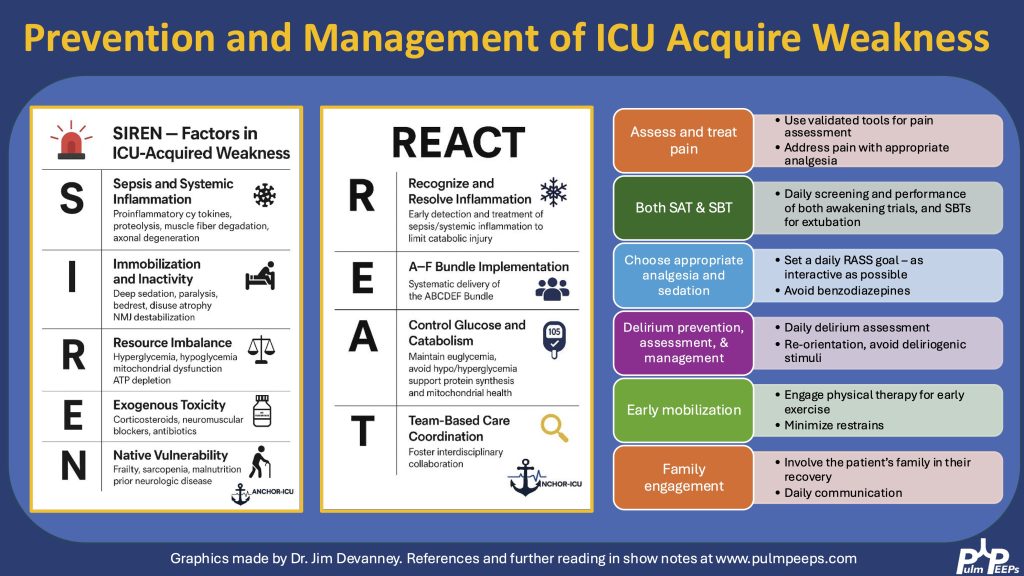
105. ICU Acquired Weakness
PulmPEEPs
Managing ICU Acquired Weakness
This chapter delves into the challenges of diagnosing and managing ICU acquired weakness, focusing on early interventions and the use of neuromuscular electric stimulation. It emphasizes the collaborative role of healthcare professionals in improving patient outcomes through aggressive therapy and comprehensive management strategies.
Today we’re talking about a topic that is relevant for all critical care physicians but under-examined: ICU Acquired Weakness. We are joined by two excellent guests to walk through a case and discuss the diagnosis, pathophysiology, prevention, and treatment of ICU Acquired Weakness. Check out our associated infographics and key learning points below.
Meet Our Guests
Jim Devanney is a Physiatrist who just completed a neurocritical care fellowship at BIDMC. He is transitioning to a clinical associate position at University Health Network – University of Toronto where he will be working as a PM&R consultant within the ICU.
Kalaila Pais is a third year internal medicine resident at BIDMC, interested in pulmonary and critical care and medical education and is returning for her third Pulm PEEPs episode.
Key Learning Points
Definition & Clinical Presentation
- Symmetric, proximal > distal weaknessRespiratory muscle involvementPreserved cranial nerve functionNo sensory deficits in myopathy (sensory loss points toward neuropathy)
- Muscle dysfunctionEarly onset (within 48 hrs)Sensation intactproximal > distal weakness
- Nerve involvementDistal > proximal weakness, sensory deficits
- Critical Illness Polyneuromyopathy (CIPNM): Combination of both
Diagnosis
- Medical Research Council Score (MRC-SS):
- Score < 48: ICU-AW
- Score < 36: severe ICU-AW
- Handgrip dynamometry: <11 kg (men), <7 kg (women)
- Electrophysiology: EMG/NCS to distinguish CIM vs CIP
- Muscle ultrasound: bedside monitoring
- MRI/CT/Muscle biopsy: rarely used due to practical limitation
Risk Factors
Modifiable:
- Hyper/hypoglycemia
- Electrolyte derangement
- Parenteral nutrition
- Immobility
- Medications (steroids, NM blockers, sedatives, aminoglycosides)
Non-modifiable:
- Age, female sex, comorbidities
- Severity of illness, prolonged ventilation
- Sepsis, multi-organ failure
Management & Prevention
- Prevention is key:
- Early treatment of sepsis and inflammation
- Glycemic control
- Early enteral nutrition
- Minimize sedation (A-F bundle)
- Early mobilization and physical therapy
- NMES (neuromuscular electrical stimulation): emerging therapy, needs more evidence
Outcomes
- Short-term: increased LOS, ventilation duration, mortality
- Long-term: decreased function, discharge to rehab, prolonged recovery
Final Takeaways
- Prevention is crucial — start interventions early.
- Systematic approach to ICU weakness helps rule out dangerous mimics.
- ICU-AW is common but often under-recognized — awareness and early rehab can significantly impact recovery.
Infographics


References and Further Reading
Clinical Practice Guidelines for the Prevention and Management of Pain, Agitation/Sedation, Delirium, Immobility, and Sleep Disruption in Adult Patients in the ICU. Devlin JW, Skrobik Y, Gélinas C, et al. Critical Care Medicine. 2018;46(9):e825-e873. doi:10.1097/CCM.0000000000003299.
The ABCDEF Bundle: Science and Philosophy of How ICU Liberation Serves Patients and Families. Ely EW. Critical Care Medicine. 2017;45(2):321-330. doi:10.1097/CCM.0000000000002175.
Caring for Critically Ill Patients With the ABCDEF Bundle: Results of the ICU Liberation Collaborative in Over 15,000 Adults. Pun BT, Balas MC, Barnes-Daly MA, et al. Critical Care Medicine. 2019;47(1):3-14. doi:10.1097/CCM.0000000000003482.
Delirium in Critical Illness: Clinical Manifestations, Outcomes, and Management. Stollings JL, Kotfis K, Chanques G, et al. Intensive Care Medicine. 2021;47(10):1089-1103. doi:10.1007/s00134-021-06503-1.
ICU-acquired Weakness. Vanhorebeek I, Latronico N, Van den Berghe G. Intensive Care Medicine. 2020;46(4):637-653. doi:10.1007/s00134-020-05944-4.
Clinical Review: Intensive Care Unit Acquired Weakness. Hermans G, Van den Berghe G. Critical Care (London, England). 2015;19:274. doi:10.1186/s13054-015-0993-7.
Best Practices for Conducting Interprofessional Team Rounds to Facilitate Performance of the ICU Liberation (ABCDEF) Bundle. Stollings JL, Devlin JW, Lin JC, et al. Critical Care Medicine. 2020;48(4):562-570. doi:10.1097/CCM.0000000000004197.
ABCDE and ABCDEF Care Bundles: A Systematic Review of the Implementation Process in Intensive Care Units. Moraes FDS, Marengo LL, Moura MDG, et al. Medicine. 2022;101(25):e29499. doi:10.1097/MD.0000000000029499.


